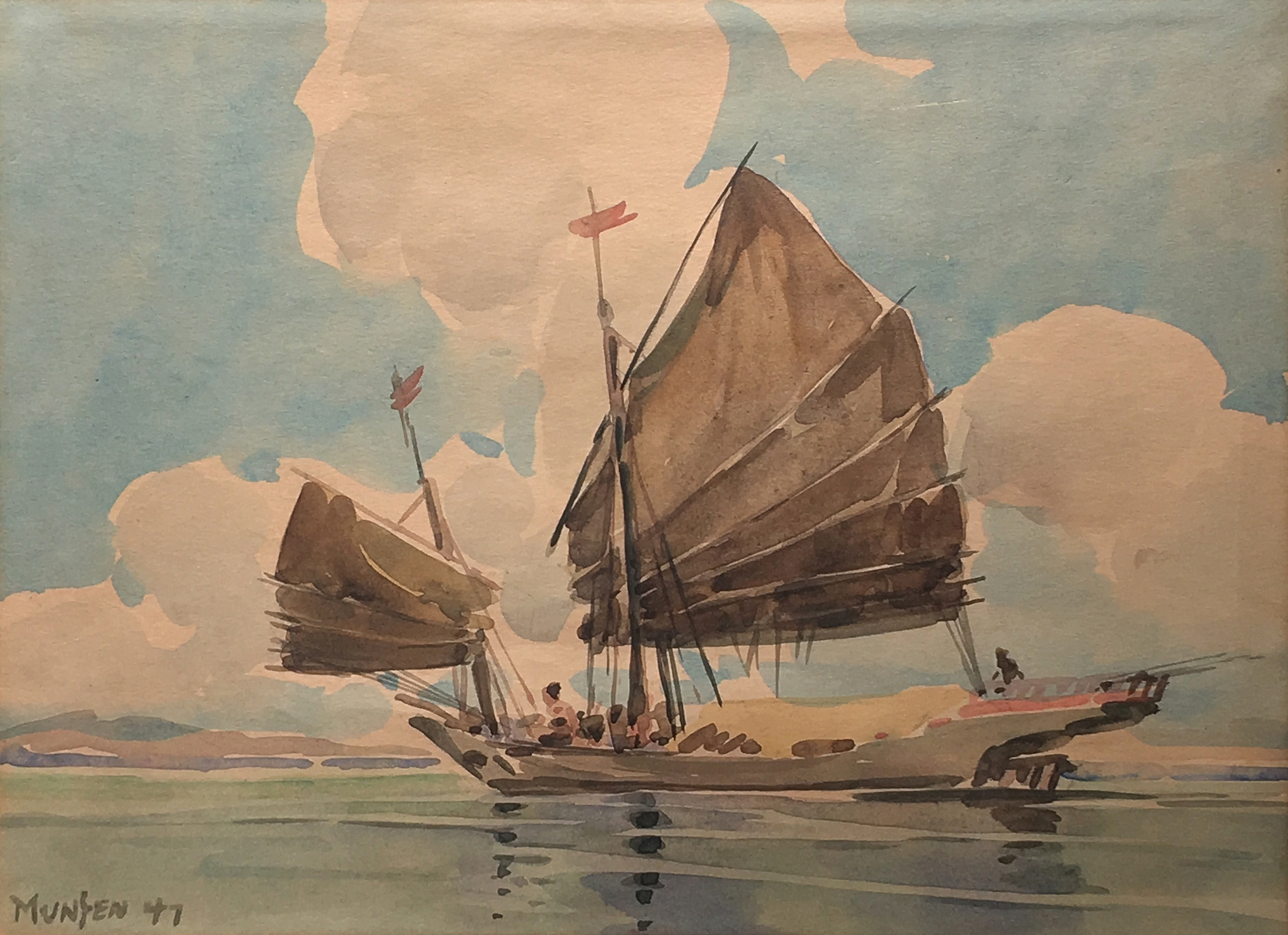LOT 43
YONG MUN SEN
B. Kuching, 1896 – 1962
Junk Sailing, 1947
Signed and dated “MUN SEN 47” on lower left
Watercolour on paper
26.5 x 36.5 cm
Provenance Private Collection, UK
The late Yong Mun Sen, born on Jan 10, 1896 was one of Malaysia’s pioneer artists. The country’s art scene wouldn’t be what it is today if it wasn’t for his contributions. The artist was born in a coconut estate in Kuching, Sarawak with the forename of Yen Lang. In 1901, he travelled to TaiPu, in the Guangdong Province of China to attain a formal education in the proper use of brush and calligraphy. He returned to his hometown in 1910.
Early Years
In 1910, Yong’s talent and interest in art piqued when he chanced upon a Japanese artist painting using watercolours at his family’s plantation and thenceforth, he became enamoured with that medium. At that opportune time, a neighbouring Dutchman presented Yong with a set of watercolours which allowed him to experiment with the medium.
Back then, being an artist didn’t rake in enough, hence, to supplement his income, Yong worked at a bookshop and subsequently opened a photography studio in Penang and most importantly, he became a self-taught artist. He used these spaces to showcase his works to the public.
In 1914, Yong went back to China and painted majestic pictures of lions and tigers which were much loved by the warlords of the time. Two years later, he married 16-year- old Lam Sek Foong who bore five children. He returned to Sarawak in 1917. A year later, he started his career at a bookshop in Singapore and served at the counter. Living in Singapore sparked a fondness and appreciation for its urban scene he later illustrated in numerous watercolours.
In 1920, Yong was transferred to the branch at Carnarvon Street in Penang. It was his first time in Penang; he saw the lovely island for what it was and was captivated by its beauty and charm.
It was in 1922 when he decided to change his name to Yong Mun Sen and subsequently set up Tai Koon Art Studio in Chulia Street. He took up photography seriously and executed some plaster-of-paris sculptures. Yong used the bookshop as well as the photography studio to showcase his works to the public. Eight years later, he moved his studio from Chulia Street to Penang Road and renamed it Mun Sen Studio.
Unfortunately, his career did not gain him any success which later prompted him to open an additional studio housed in an old mansion in Northam Road. During this time, Yong familiarised himself with the works of prominent European artists through books, particularly those of Van Gogh and Gauguin. Gauguin and his works spoke to Yong, which explains the strong influence on the development of his style, especially in his oil paintings.
Around 1936, several Penang artists happened to meet up and decided to form their brainchild, the Penang Chinese Art Club, with Yong as the vice-president. He became the president the following year. With the onset of the Second World War in 1939, the Penang Chinese Art Club was disbanded never to be formed again. When the Japanese occupied Malaya from 1941 to 1945, for him, this was the most fruitless period of his life. He had to resort to farming for the sake of survival.
The streak of misfortune continued when his wife died in 1941. Soon after, he remarried to the beautiful Yao Chew Mooi, the daughter of Yao Swee Lum from Ipoh (a descendant of Kapitan China, Yap Ah Loy). She eventually gave birth to four sons and two daughters.
Post-war, the artist got back on track and delved into the art scene actively and soon after, he became well known through his exhibitions in Malaya and Singapore and also through foreign contacts in Britain, USA and Australia.
Artistic Style
Yong’s forte and heart were landscapes in watercolour. With Western impressionism, complemented by Chinese calligraphy aesthetics, Yong garnered aficionados from the US, Australia and the UK. When Yong came across a scene that spoke to his soul, he would swiftly set up his easel and camp stool, equipped with a brush in hand to relay it on the canvas.
Yong’s identification of his subjects’ struggles, including fishermen in seaside villagers, farmers in paddy fields and labourers in plantations took centre stage. His conveyance grants viewers with an immaculate escape, a breath of fresh air or to remind people to break away from the bustling life. It is also evident in his landscape paintings that Yong did not depict the details that made up a landscape, rather, through watercolour, he illustrated fluidity and a carefree rhythm.
Later Years
In 1956, he had the first of several strokes. Undeterred by his physical infirmity, he struggled on to paint. Although Yong was touted as the first known painter and artist in Malaysian modern art, his life in the later years was burdened with poverty, illness, depression and despair. He died on Sept 29, 1962 from stomach cancer.
A decade later, in 1972, the National Art Gallery organised a Mun Sen Memorial Art Exhibition. Yong’s works will always hold a distinguished place in Malaysian art, as they rightfully deserve.
